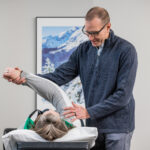 Introduction
Introduction
At Altitude Physical Therapy, we understand the critical role that your hips play in everyday movements, from walking and running to sitting and standing. Hip health is paramount for maintaining your overall mobility and quality of life. In this blog, we’ll delve into the anatomy of the hips, common issues that can affect them, and how physical therapy can alleviate hip pain and improve function.
Anatomy of the Hips
The hip joint is a ball-and-socket joint that allows for a wide range of motion. It is one of the largest and most stable joints in the body, designed to bear weight and facilitate movement. (https://my.clevelandclinic.org/health/body/24675-hip-joint)
- Femur: The thigh bone, or femur, has a rounded head (the ball) that fits into the hip socket.
- Acetabulum: The socket part of the joint, located in the pelvis.
- Labrum: A rim of soft tissue or fibrous cartilage that surrounds the socket of a ball and socket joint to make it more stable.
- Cartilage: A layer of smooth cartilage covers the femoral head and the acetabulum, allowing for frictionless movement.
- Ligaments and Tendons: These connective tissues stabilize the hip joint.
- Muscles: Several muscles surround the hip joint, including the gluteals, hip flexors, and adductors, all contributing to hip movement and stability.
Common Hip Issues
 Hip problems can arise from various causes, including injury, overuse, and medical conditions. Here are some common issues:
Hip problems can arise from various causes, including injury, overuse, and medical conditions. Here are some common issues:
- Osteoarthritis: This degenerative joint disease is characterized by the breakdown of cartilage, leading to pain and stiffness.
- Bursitis: Inflammation of the bursae, fluid-filled sacs that cushion the hip joint, can cause pain and discomfort.
- Hip Labral Tears: Damage to the ring of cartilage (labrum) that follows the outside rim of the hip joint socket can cause pain and instability.
- Tendinitis: Inflammation or irritation of the tendons around the hip, often due to overuse or repetitive stress.
- Hip Fractures: Common in older adults, especially those with osteoporosis, hip fractures require immediate medical attention.
- Muscle Strains: Overstretching or tearing of muscles around the hip can occur during sports or other physical activities.
How Physical Therapy Can Help
 Physical therapy plays a crucial role in managing and treating hip pain. At Altitude Physical Therapy, our experienced therapists tailor treatment plans to meet your specific needs, aiming to reduce pain, restore function, and improve your quality of life. (https://www.altitudept.com/treatments/hip-pain/)
Physical therapy plays a crucial role in managing and treating hip pain. At Altitude Physical Therapy, our experienced therapists tailor treatment plans to meet your specific needs, aiming to reduce pain, restore function, and improve your quality of life. (https://www.altitudept.com/treatments/hip-pain/)
Initial Assessment
Your journey to hip health begins with a comprehensive evaluation. Our therapists will assess your range of motion, strength, and overall hip function. This assessment helps us understand the underlying cause of your hip pain and develop a personalized treatment plan.
Treatment Techniques
- Manual Therapy: Hands-on techniques to mobilize the hip joint and surrounding tissues, improving mobility and reducing pain.
- Therapeutic Exercises: Customized exercise programs to strengthen the muscles around the hip, enhance flexibility, and promote stability.
- Education and Training: Guidance on proper posture, body mechanics, and activity modifications to prevent further injury.
- Gait Training: For those with walking difficulties, gait training can help improve your walking pattern and reduce pain.
Benefits of Physical Therapy for Hip Pain
- Pain Relief: Targeted treatments to reduce pain and inflammation.
- Improved Mobility: Increased range of motion and flexibility.
- Enhanced Strength: Stronger muscles to support and stabilize the hip joint.
- Better Functionality: Improved ability to perform daily activities and engage in physical activity.
- Prevention of Future Injuries: Education and exercises to prevent recurrence of hip problems.
Conclusion
Hip pain doesn’t have to limit your life. At Altitude Physical Therapy, we are committed to helping you achieve optimal hip health through personalized, effective physical therapy treatments. If you’re experiencing hip pain, don’t wait—contact us today to schedule an assessment and take the first step towards a pain-free life.
For more information, visit our website at https://www.altitudept.com/contactus


